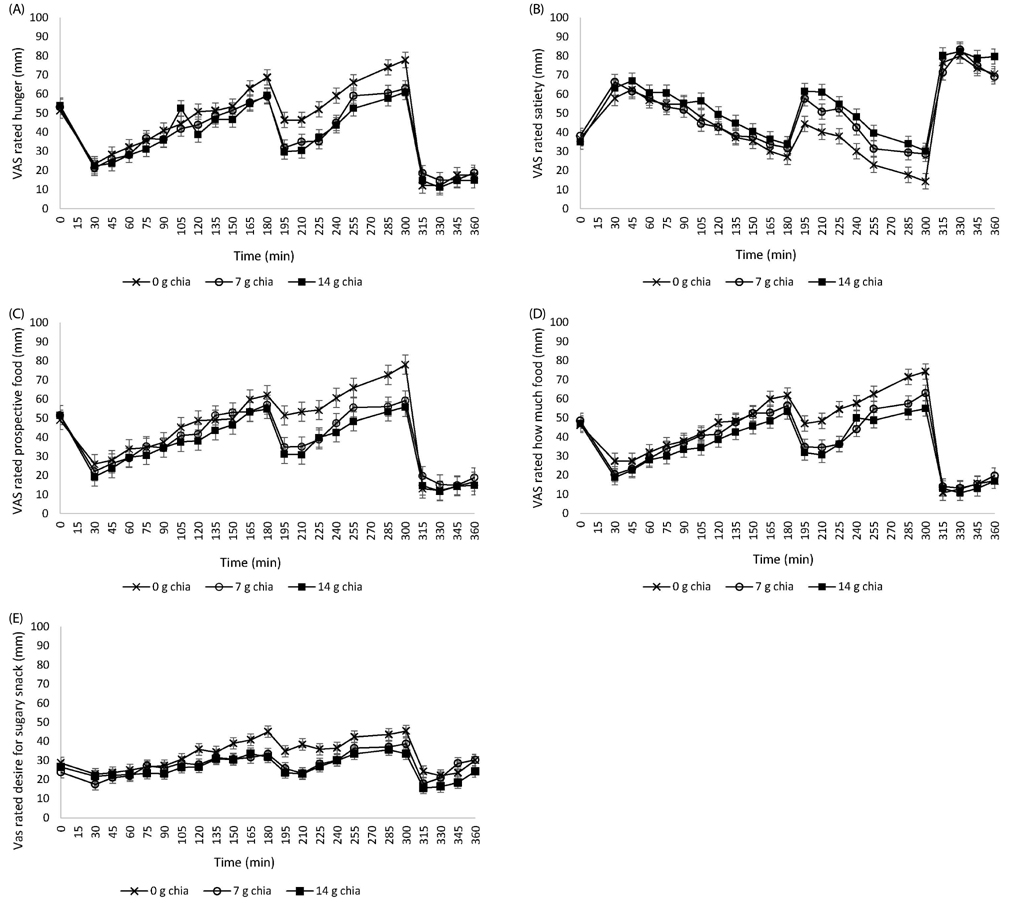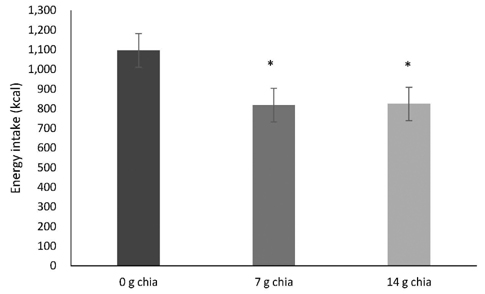Nutr Res Pract.
2017 Oct;11(5):412-418. 10.4162/nrp.2017.11.5.412.
Chia seed (Salvia Hispanica L.) added yogurt reduces short-term food intake and increases satiety: randomised controlled trial
- Affiliations
-
- 1Department of Nutrition and Dietetics, Faculty of Health Sciences, Hacettepe University, Sihhiye, Ankara 06100, Turkey. baylin@hacettepe.edu.tr
- 2Department of Medical Biochemistry, Faculty of Medicine, Hacettepe University, Sihhiye, Ankara 06100, Turkey.
- KMID: 2390134
- DOI: http://doi.org/10.4162/nrp.2017.11.5.412
Abstract
- BACKGROUND/OBJECTIVES
Several studies have reported that consumption of Salvia Hispanica L.,commonly known as chia seed, may exert beneficial effects on health outcomes. The main purpose of this study was to examine the influence of chia seed consumption as a mid-morning snack on short-term satiety.
SUBJECTS/METHODS
Subjects (n = 24) were tested using a randomized, cross-over design consisting of three mid-morning snacks. Yogurt with no chia seed, yogurt with 7 g chia seed, and yogurt with 14 g chia seed were given to subjects on different test days. After subjects were asked to report visual analog scale (VAS) scores on sensory outcomes, ad libitum lunch was served, and energy intake of individuals was measured.
RESULTS
VAS scores indicated that participants reported significantly lower scores for hunger (P = 0.033), prospective food consumption (P = 0.031), amounts of food that could be consumed (P = 0.017), desire for sugary foods (P = 0.015), and higher scores for satiety (P = 0.031) on the test days with 7 g and 14 g chia seed. Energy intake of individuals during ad libitum lunch was significantly lower when they consumed yogurt with 7 g or 14 g chia seed (P = 0.037).
CONCLUSIONS
The study demonstrated that chia seed consumption as a mid-morning snack may induce short-term satiety in healthy individuals.
Keyword
MeSH Terms
Figure
Reference
-
1. Sofer S, Stark AH, Madar Z. Nutrition targeting by food timing: time-related dietary approaches to combat obesity and metabolic syndrome. Adv Nutr. 2015; 6:214–223.
Article2. Jung HS, Lim Y, Kim EK. Therapeutic phytogenic compounds for obesity and diabetes. Int J Mol Sci. 2014; 15:21505–21537.
Article3. Aoe S, Ikenaga T, Noguchi H, Kohashi C, Kakumoto K, Kohda N. Effect of cooked white rice with high β-glucan barley on appetite and energy intake in healthy Japanese subjects: a randomized controlled trial. Plant Foods Hum Nutr. 2014; 69:325–330.
Article4. Perrigue MM, Monsivais P, Drewnowski A. Added soluble fiber enhances the satiating power of low-energy-density liquid yogurts. J Am Diet Assoc. 2009; 109:1862–1868.
Article5. Ewart-Pierce E, Mejía Ruiz MJ, Gittelsohn J. “Whole-of-Community” obesity prevention: a review of challenges and opportunities in multilevel, multicomponent interventions. Curr Obes Rep. 2016; 5:361–374.
Article6. Ullah R, Nadeem M, Khalique A, Imran M, Mehmood S, Javid A, Hussain J. Nutritional and therapeutic perspectives of chia (Salvia hispanica L.): a review. J Food Sci Technol. 2016; 53:1750–1758.
Article7. Ayerza R, Coates W. Composition of chia (Salvia hispanica) grown in six tropical and subtropical ecosystems of South America. Trop Sci. 2004; 44:131–135.
Article8. Mohd Ali N, Yeap SK, Ho WY, Beh BK, Tan SW, Tan SG. The promising future of chia, Salvia hispanica L. J Biomed Biotechnol. 2012; 2012:171956.9. Valdivia-López MÁ, Tecante A. Chia (Salvia hispanica): a review of native mexican seed and its nutritional and functional properties. Adv Food Nutr Res. 2015; 75:53–75.10. Julio LM, Ixtaina VY, Fernández M, Torres Sánchez RM, Nolasco SM, Tomás MC. Development and characterization of functional O/W emulsions with chia seed (Salvia hispanica L.) by-products. J Food Sci Technol. 2016; 53:3206–3214.
Article11. Sandoval-Oliveros MR, Paredes-López O. Isolation and characterization of proteins from chia seeds (Salvia hispanica L.). J Agric Food Chem. 2013; 61:193–201.
Article12. Reyes-Caudillo E, Tecante A, Valdivia-López MA. Dietary fibre content and antioxidant activity of phenolic compounds present in Mexican chia (Salvia hispanica L.) seeds. Food Chem. 2008; 107:656–663.
Article13. Menga V, Amato M, Phillips TD, Angelino D, Morreale F, Fares C. Gluten-free pasta incorporating chia (Salvia hispanica L.) as thickening agent: an approach to naturally improve the nutritional profile and the in vitro carbohydrate digestibility. Food Chem. 2017; 221:1954–1961.
Article14. Vuksan V, Whitham D, Sievenpiper JL, Jenkins AL, Rogovik AL, Bazinet RP, Vidgen E, Hanna A. Supplementation of conventional therapy with the novel grain Salba (Salvia hispanica L.) improves major and emerging cardiovascular risk factors in type 2 diabetes: results of a randomized controlled trial. Diabetes Care. 2007; 30:2804–2810.
Article15. Toscano LT, da Silva CS, Toscano LT, de Almeida AE, Santos Ada C, Silva AS. Chia flour supplementation reduces blood pressure in hypertensive subjects. Plant Foods Hum Nutr. 2014; 69:392–398.
Article16. Valenzuela R, Bascuñán K, Chamorro R, Barrera C, Sandoval J, Puigrredon C, Parraguez G, Orellana P, Gonzalez V, Valenzuela A. Modification of docosahexaenoic acid composition of milk from nursing women who received alpha linolenic acid from chia oil during gestation and nursing. Nutrients. 2015; 7:6405–6424.
Article17. Jin F, Nieman DC, Sha W, Xie G, Qiu Y, Jia W. Supplementation of milled chia seeds increases plasma ALA and EPA in postmenopausal women. Plant Foods Hum Nutr. 2012; 67:105–110.
Article18. Ho H, Lee AS, Jovanovski E, Jenkins AL, Desouza R, Vuksan V. Effect of whole and ground Salba seeds (Salvia Hispanica L.) on postprandial glycemia in healthy volunteers: a randomized controlled, dose-response trial. Eur J Clin Nutr. 2013; 67:786–788.
Article19. Vuksan V, Jenkins AL, Dias AG, Lee AS, Jovanovski E, Rogovik AL, Hanna A. Reduction in postprandial glucose excursion and prolongation of satiety: possible explanation of the long-term effects of whole grain Salba (Salvia Hispanica L.). Eur J Clin Nutr. 2010; 64:436–438.
Article20. Razzaq HA, Sutton KH, Motoi L. Modifying glucose release from high carbohydrate foods with natural polymers extracted from cereals. J Sci Food Agric. 2011; 91:2621–2627.
Article21. Doyon CY, Tremblay A, Rioux LE, Rhéaume C, Cianflone K, Poursharifi P, Turgeon SL. Acute effects of protein composition and fibre enrichment of yogurt consumed as snacks on appetite sensations and subsequent ad libitum energy intake in healthy men. Appl Physiol Nutr Metab. 2015; 40:980–989.
Article22. Arshad MU, Ishtiaq S, Anjum FM, Saeed F, Chatha SA, Imran A. Acute effects of different dietary polysaccharides added in milk on food intake, postprandial appetite and glycemic responses in healthy young females. Int J Food Sci Nutr. 2016; 67:715–722.
Article23. Nieman DC, Cayea EJ, Austin MD, Henson DA, McAnulty SR, Jin F. Chia seed does not promote weight loss or alter disease risk factors in overweight adults. Nutr Res. 2009; 29:414–418.
Article24. Lieberman HR, Wurtman JJ, Chew B. Changes in mood after carbohydrate consumption among obese individuals. Am J Clin Nutr. 1986; 44:772–778.
Article25. Osdoba KE, Mann T, Redden JP, Vickers Z. Using food to reduce stress: effects of choosing meal components and preparing a meal. Food Qual Prefer. 2015; 39:241–250.
Article26. Cardello AV, Meiselman HL, Schutz HG, Craig C, Given Z, Lesher LL, Eicher S. Measuring emotional responses to foods and food names using questionnaires. Food Qual Prefer. 2012; 24:243–250.
Article27. King SC, Meiselman HL, Carr BT. Measuring emotions associated with foods in consumer testing. Food Qual Prefer. 2010; 21:1114–1116.
Article28. Mento C, Le Donne M, Crisafulli S, Rizzo A, Settineri S. BMI at early puerperium: body image, eating attitudes and mood states. J Obstet Gynaecol. 2017; 37:428–434.
Article29. Kien CL, Bunn JY, Tompkins CL, Dumas JA, Crain KI, Ebenstein DB, Koves TR, Muoio DM. Substituting dietary monounsaturated fat for saturated fat is associated with increased daily physical activity and resting energy expenditure and with changes in mood. Am J Clin Nutr. 2013; 97:689–697.
Article30. Blundell J, de Graaf C, Hulshof T, Jebb S, Livingstone B, Lluch A, Mela D, Salah S, Schuring E, van der Knaap H, Westerterp M. Appetite control: methodological aspects of the evaluation of foods. Obes Rev. 2010; 11:251–270.
Article31. Flint A, Raben A, Blundell JE, Astrup A. Reproducibility, power and validity of visual analogue scales in assessment of appetite sensations in single test meal studies. Int J Obes Relat Metab Disord. 2000; 24:38–48.
Article32. Selvi Y, Gulec M, Aydin A, Besiroglu L. Psychometric evaluation of the Turkish language version of the Profile of Mood States (POMS). J Mood Disord. 2011; 1:152–161.
Article33. Tabachnick BG, Fidell LS. Using Multivariate Statistics. 3rd ed. New York (NY): HarperCollins College Publishers;1996.34. European Commission. Commission Implementing Decision of 22 January 2013: authorising an extension of use of chia (Salvia hispanica) seed as a novel food ingredient under Regulation (EC) No 258/97 of the European Parliament and of the Council (2013/50/EU). Brussels: Official Journal of the European Union;2013.35. Veldhorst MA, Nieuwenhuizen AG, Hochstenbach-Waelen A, van Vught AJ, Westerterp KR, Engelen MP, Brummer RJ, Deutz NE, Westerterp-Plantenga MS. Dose-dependent satiating effect of whey relative to casein or soy. Physiol Behav. 2009; 96:675–682.
Article36. Vuksan V, Choleva L, Jovanovski E, Jenkins AL, Au-Yeung F, Dias AG, Ho HV, Zurbau A, Duvnjak L. Comparison of flax (Linum usitatissimum) and Salba-chia (Salvia hispanica L.) seeds on postprandial glycemia and satiety in healthy individuals: a randomized, controlled, crossover study. Eur J Clin Nutr. 2017; 71:234–238.
Article37. Benini L, Castellani G, Brighenti F, Heaton KW, Brentegani MT, Casiraghi MC, Sembenini C, Pellegrini N, Fioretta A, Minniti G, Porrini M, Testolin G, Vantini I. Gastric emptying of a solid meal is accelerated by the removal of dietary fibre naturally present in food. Gut. 1995; 36:825–830.
Article38. Buckley JD, Howe PR. Long-chain omega-3 polyunsaturated fatty acids may be beneficial for reducing obesity-a review. Nutrients. 2010; 2:1212–1230.
Article39. Harden CJ, Dible VA, Russell JM, Garaiova I, Plummer SF, Barker ME, Corfe BM. Long-chain polyunsaturated fatty acid supplementation had no effect on body weight but reduced energy intake in overweight and obese women. Nutr Res. 2014; 34:17–24.
Article40. Kral TV, Roe LS, Rolls BJ. Combined effects of energy density and portion size on energy intake in women. Am J Clin Nutr. 2004; 79:962–968.
Article41. De Graaf C, De Jong LS, Lambers AC. Palatability affects satiation but not satiety. Physiol Behav. 1999; 66:681–688.
Article42. Borneo R, Aguirre A, León AE. Chia (Salvia hispanica L) gel can be used as egg or oil replacer in cake formulations. J Am Diet Assoc. 2010; 110:946–949.
Article43. Rodrigues JB, Paixão JA, Cruz AG, Bolini HM. Chocolate milk with chia oil: ideal sweetness, sweeteners equivalence, and dynamic sensory evaluation using a time-intensity methodology. J Food Sci. 2015; 80:S2944–S2949.
Article44. Luna Pizarro P, Almeida EL, Coelho AS, Sammán NC, Hubinger MD, Chang YK. Functional bread with n-3 alpha linolenic acid from whole chia (Salvia hispanica L.) flour. J Food Sci Technol. 2015; 52:4475–4482.
Article45. Li XE, Jervis SM, Drake MA. Examining extrinsic factors that influence product acceptance: a review. J Food Sci. 2015; 80:R901–R909.
Article46. Leidy HJ, Todd CB, Zino AZ, Immel JE, Mukherjea R, Shafer RS, Ortinau LC, Braun M. Consuming high-protein soy snacks affects appetite control, satiety, and diet quality in young people and influences select aspects of mood and cognition. J Nutr. 2015; 145:1614–1622.
Article47. Vuksan V, Jenkins AL, Brissette C, Choleva L, Jovanovski E, Gibbs AL, Bazinet RP, Au-Yeung F, Zurbau A, Ho HV, Duvnjak L, Sievenpiper JL, Josse RG, Hanna A. Salba-chia (Salvia hispanica L.) in the treatment of overweight and obese patients with type 2 diabetes: a double-blind randomized controlled trial. Nutr Metab Cardiovasc Dis. 2017; 27:138–146.
Article48. Asarian L, Geary N. Sex differences in the physiology of eating. Am J Physiol Regul Integr Comp Physiol. 2013; 305:R1215–R1267.
Article49. Provencher V, Jacob R. Impact of perceived healthiness of food on food choices and intake. Curr Obes Rep. 2016; 5:65–71.
Article
- Full Text Links
- Actions
-
Cited
- CITED
-
- Close
- Share
- Similar articles
-
- Effectiveness of Topical Chia Seed Oil on Pruritus of End-stage Renal Disease (ESRD) Patients and Healthy Volunteers
- Comparative Analysis of Perception Volume, Intake Volume, and Satiety Rate of Rice, Soup and Side Dishes Using Tableware and Food Tray
- The Relationship between Food Intake, Sodium Intake and Satiety Rate and the Methods of Consuming Soup
- Effects of Food Consumption Monitoring Using Modified Rice Bowls on Food Intake, Satiety Rate, and Eating Rate
- Comparison of Calorie Intake and Satiety Rate by Different Energy Density Level of Kimbab



